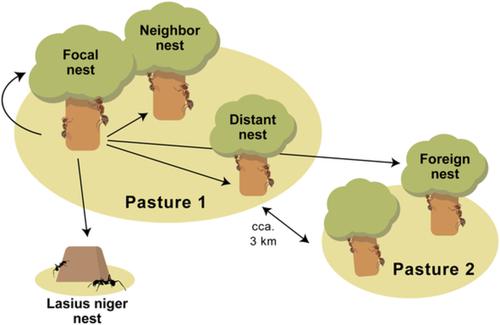当前位置:
X-MOL 学术
›
Entomol. Sci.
›
论文详情
Our official English website, www.x-mol.net, welcomes your
feedback! (Note: you will need to create a separate account there.)
Friend or foe? Differential aggression towards neighbors and strangers in the ant Liometopum microcephalum (Hymenoptera: Formicidae)
Entomological Science ( IF 0.7 ) Pub Date : 2020-09-01 , DOI: 10.1111/ens.12433 Kriszta‐Kincső Keresztes 1, 2 , Enikő Csata 1, 2 , Tekla A. Lunka 1 , Bálint Markó 1, 2
Entomological Science ( IF 0.7 ) Pub Date : 2020-09-01 , DOI: 10.1111/ens.12433 Kriszta‐Kincső Keresztes 1, 2 , Enikő Csata 1, 2 , Tekla A. Lunka 1 , Bálint Markó 1, 2
Affiliation

|
Intra‐ and interspecific aggression is quite common in ants, from occasional conflicts to large‐scale territorial disputes. The “nasty neighbor” phenomenon describes the differential aggressive treatment of neighbors versus foreign intruders. Due to the fact that workers of a given colony meet rival neighbors more often at food resources, they treat them as threats to their colony. The reverse can also happen: the “dear enemy” effect arises when an already known rival is treated less aggressively due to accommodation, than an unknown distant one. In the current study, we analyzed the effect of distance on the aggressiveness of Liometopum microcephalum, a territorial arboricolous ant, towards non‐nestmates in two large populations. Our results show that aggression did not increase with distance, but it was higher among neighbors than among workers coming from distant nests. The results of the study are consistent with the nasty neighbor scenario, and do not support the hypothesis that the studied populations would be polydomous systems of interconnected nests.
中文翻译:

是敌是友?Liometopum microcephalum(膜翅目:蚁科)对邻居和陌生人的差异攻击
从偶尔的冲突到大规模的领土争端,蚂蚁的种内和种间侵略非常普遍。“讨厌的邻居”现象描述了邻居对外国入侵者的不同侵略性对待。由于特定殖民地的工人在食物资源方面更频繁地遇到竞争对手的邻居,他们将他们视为对其殖民地的威胁。反过来也可能发生:当一个已知的对手由于迁就而受到的对待比不知名的远方对手更不积极时,就会出现“亲爱的敌人”效应。在当前的研究中,我们分析了距离对 Liometopum microcephalum(一种领地树蚂蚁)对两个大种群中的非巢穴伙伴的攻击性的影响。我们的结果表明,攻击性不会随着距离的增加而增加,但邻居之间的比例高于来自遥远巢穴的工人。该研究的结果与讨厌的邻居情景一致,并且不支持所研究的种群将是相互连接的巢穴的多角系统的假设。
更新日期:2020-09-01
中文翻译:

是敌是友?Liometopum microcephalum(膜翅目:蚁科)对邻居和陌生人的差异攻击
从偶尔的冲突到大规模的领土争端,蚂蚁的种内和种间侵略非常普遍。“讨厌的邻居”现象描述了邻居对外国入侵者的不同侵略性对待。由于特定殖民地的工人在食物资源方面更频繁地遇到竞争对手的邻居,他们将他们视为对其殖民地的威胁。反过来也可能发生:当一个已知的对手由于迁就而受到的对待比不知名的远方对手更不积极时,就会出现“亲爱的敌人”效应。在当前的研究中,我们分析了距离对 Liometopum microcephalum(一种领地树蚂蚁)对两个大种群中的非巢穴伙伴的攻击性的影响。我们的结果表明,攻击性不会随着距离的增加而增加,但邻居之间的比例高于来自遥远巢穴的工人。该研究的结果与讨厌的邻居情景一致,并且不支持所研究的种群将是相互连接的巢穴的多角系统的假设。









































 京公网安备 11010802027423号
京公网安备 11010802027423号